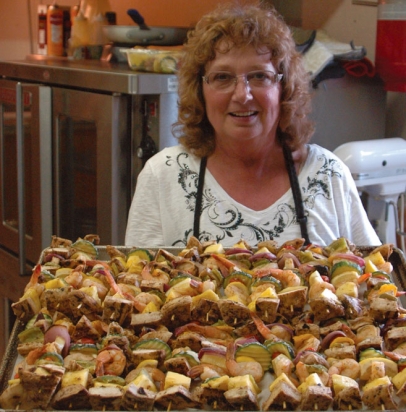Lady Di's Kitchen
For the past several summers, Dianna Isder has served as head chef at the Iowa Lakeside Laboratory, a 147-acre biological field station that offers college courses and research opportunities in the Iowa Great Lakes region. During my recent writing residency at the site, I assisted Dianna and her staff while they prepared for the Macbride Dinner, an annual celebration hosted in honor of the Lab’s conservation-minded benefactors. Surviving 13 long hours in the kitchen, here is my story of learning about food, life and love from a wisecracking former school cook who has rightfully earned the nickname “Lady Di” from her many admiring diners.
Thursday, July 16, 2015, 5:45 a.m.: Upon entering the kitchen, Dianna smiles and immediately offers me a cup of coffee. I accept and watch as she fries sausage in a large skillet. The National Anthem plays in the background, despite the fact that July Fourth occurred two weeks ago–I’m not sure if this is Lady Di’s daily wake-up routine or simply a belated act of patriotism from the local radio station. Dianna was going to make pancakes for breakfast but is doing biscuits and gravy instead, as two interns recently told her that the dish is like an “orgasm in your pants,” though her word choice is much raunchier.
6:10 a.m.: In regards to her history at Lakeside, Dianna tells me that she joined the dining staff in 2003, during which the head chef cooked no more than 15 different dishes that would rotate throughout the summer. As a former school cook, Dianna resented the limited menu and pushed the other staff members to prepare more variety–despite the initial pushback, her voice was heard. “Within a year, the kitchen was mine.” For personal reasons, however, Dianna left for two years, during which the meals at Lakeside turned into what she calls “food service hell.” When Dr. Michael J. Lannoo was offered the position of academic director, he only agreed to do so if Dianna returned, and she obliged after he approached her in person with a heart-felt plea. “Mike’s the first one to admit that this place had been neglected, and I give him a lot of credit for turning Lakeside back into the community it is now.”
6:31 a.m.: As Dianna and I talk about our love of dessert, her husband John enters the kitchen, after which she kisses him and whispers, “Speaking of sweet…” She packs John a lunch of meatballs while he gathers a slop bucket filled with food waste. These Lakeside-approved leftovers are used to feed the couple’s four hogs, which they raise on a friend’s land alongside cattle, chickens and turkeys.
6:43 a.m.: To deliver a 15-minutes-til-breakfast warning, Dianna walks outside to a rusted tire rim strung from a tree and strikes it with hammer. “I always wish we’d get a real bell,” she says upon her return. “That’s the hardest thing to get people to do–ring that bell. You feel like an idiot with a hammer in your hand.”
6:55 a.m.: After Dianna rings the bell again, she asks me to open the door for the 40 interns, students, faculty and staff who eat here, joking, “As Moses would say, ‘Let my people go.” Before she even has her first full table of seated patrons, she begins working on lunch.
8:13 a.m.: I stack chairs and move tables so that the floors can be deep cleaned in preparation for tonight’s Macbride Dinner, an event that Dianna deems “a career meal.” Janet Hazen, a newly hired staff member and former school librarian, arrives for her shift. While we move furniture, Dianna bakes croutons coated in butter and “gourmet garlic seasoning–this summer’s secret ingredient.”
8:44 a.m.: Staff member Mary Thelen arrives and joins her co-workers. The three women–whom Dianna refers to as “the Golden Girls”–begin slicing and dicing: zucchini for Dianna, pineapple for Janet and grapes for Mary, who later informs me that one of her 15 siblings also works in the kitchen at night.
8:57 a.m.: When I ask about food costs, Dianna notes that she exceeded her given budget last year because fresh food–often from the farmers’ market–is more expensive than the low quality ingredients that were prepared during her absence. However, Dianna firmly defends the expenditures needed to run her kitchen properly. “I’m not going to compromise what I make and use convenience food,” she says. “I’m not. I’m just not.”
9:15 a.m.: Intern Dana DeCrane Norton arrives to offer help. Doting on Dana, Dianna eagerly escorts us to the walk-in freezer, where she displays her Macbride Dinner chicken that has been marinating in Italian dressing for several days. She then shows off a pair of vibrantly colored ice cream rolls–vanilla cake with strawberry ice cream and chocolate cake with vanilla ice cream–that Janet provided the secret family recipe for.
10:09 a.m.: To begin making kabobs for the 100 guests expected tonight, Dianna places the marinated chicken on the grill. As it chars, she fills two large tubs with shrimp and coats them with melted butter. “We’re going to use ten pounds before the day’s over,” she says (referring to butter, not shrimp).
10:40 a.m.: “We should probably take five,” Dianna says, sliding bread into the toaster. I leave to take a quick nap. When I return, Dianna eats a hummus, butter and tomato sandwich. I comment on the oddity of such a snack but Dianna simply moans in pleasure. Mary tells us that she’s never had hummus before. She takes a bite and says, “Wouldn’t be my favorite.”
11:11 a.m.: I ask Dianna about her upbringing and she replies that she was a bit of a wild child. As punishment, she relocated to St. Paul to attend Home of the Good Shepherd, a Catholic school for so-called “soft offenders.” While there, one of Dianna’s duties included preparing meals, and she soon discovered a passion that realigned her life in a positive new direction.
11:20 a.m.: While Mary makes fresh whipped cream in a stand mixer, Dianna and Janet set out what they call an “easy” lunch: pita bread, roast lamb, turkey, ham, tuna salad, egg salad, cheddar, Swiss, pepper jack, feta, tomatoes, cucumbers, green onions, pickles, mayo, mustard, ketchup, barbecue sauce, Bulgarian yogurt sauce, Sriracha, hummus, garden salad with six different options of dressing, beets, peaches, broccoli salad, potato salad, sugar cookies and lemon squares.
11:45 a.m.: Lunch is nearly complete. “Time to ding the dong,” Dianna says, asking Mary to wield the all-mighty hammer. I accompany her outside in hopes of taking a picture but the sound is so ear-piercing that I nearly drop my camera.
12:27 p.m.: After lunch, I ask Dianna if she’s eaten anything since her hummus and butter sandwich, and she shrugs, saying that her years as a school cook weaned her to eat at odd hours. “Trust me, you get used to eating chili at nine in the morning.”
2:52 p.m.: I return from yet another nap and find Dianna, newly changed into black gaucho pants and a beaded shirt, assembling her kabobs alongside Leslie Morales-Mza, who fills the shift recently vacated by Janet and Mary. We discuss pickles and the joys of gardening.
3:19 p.m.: While baking dinner rolls, I ask Dianna why she left her job with the public school system, and she tells me that she and the principal didn’t exactly see eye to eye–so much so that her district’s new high school was built without a kitchen, forcing her to prepare food in a separate building. However, the true kicker arrived with Michelle Obama’s “Let’s Move!” campaign, which restricted many of Dianna’s from-scratch lunches. Though
she believes in the mindset behind the federal program, Dianna feels like it falls short in practicality. “I’ve got eight grandkids and they all say the same thing–they’re starving at school. It’s going the other way, cause when you’re hungry, what do you reach for at home? It’s definitely not asparagus.”
4:04 p.m.: Dianna boils three varieties of wild rice with vegetable stock and minced onion, carrots and celery. While pouring kabob drippings into the mixture for extra zing, she looks at me and suddenly asks, “Are you married?” For the next twenty minutes, I manage to tell Dianna the majority of my entire life story–an attentive and trusting listener, Dianna proves the she’s worthy of her own daytime talk show.
4:25 p.m.: Still assembling kabobs, Dianna worries that she used too much shrimp and might have to make a few vegetable-heavy stacks. Growing anxious, she asks that I double-check the table count to ensure that we have exactly 100 seats for her 100 soon-to-be masterpieces.
5:05 p.m.: Sue Lannoo, the academic director’s wife, arrives to lend her support. Dianna welcomes her by stirring the rice, revealing an alluring and rich aroma. Dana soon returns and helps Sue and I place breadbaskets on tables decorated with prairie flowers. Once finished, we are offered sample kabob vegetables, which are delicious, smoky and perfectly spiced. Our joy doesn’t last long, however, as we realize that we’re short an entire table of bread. Dianna scrambles for a combination of biscuits, croissants, French bread, whatever she can find. With victory in sight, she pulls vodka from a corner cabinet and makes a screwdriver with a splash of lemonade. She then offers to make one for everyone else, promising that this is the only time she drinks at work. With a sip of inspiration, she decides to throw a last-minute sweet chili glaze on the kabobs before placing them in the oven.
5:41 p.m.: When asked to describe her cooking philosophy in one sentence or less, Dianna provides her finest wisdom of the day: “Let me tell you, I got hypnotized to quit smoking, and when I’m cooking I feel like I’m being hypnotized all over again.”
5:50 p.m.: As guests first begin to arrive, Dianna tosses together a Caesar-style salad, continually telling me that she’s “massaging” the lettuce in faux culinary pretentiousness. She then gives gloves to her surrounding five helpers so they can dish out and garnish salad after salad in an assembly line deemed “the Crouton Express.” To entertain us, Dianna recounts a story of working at a factory in which she was paid $14 an hour to make 72 sandwiches per minute. “Every day I walked up those stairs and thought, ‘Have I died and gone to hell?’”
6:04 p.m.: After the salads are done, Dianna forces me to leave the kitchen–it’s finally time to drink wine and celebrate the Friends of Lakeside Lab, an organization that has raised money and community support for the research station since 1994.
6:32 p.m.: Salads are served once we take our seats, followed by a second course of wild rice and kabobs layered with chicken, shrimp, peppers, onions, zucchini, cherry tomatoes, lemon, pineapple and a garlic-butter sweet chili drizzle. Friends of Lakeside Lab executive director Lisa Roti, Dr. Lannoo and a quartet of interns then deliver gushing speeches about the importance of conservation science as we eat ice cream rolls dolloped with chocolate, fresh strawberries and homemade whipped cream. I could easily eat four more plates of everything.
8:26 p.m.: After helping with dishes, I find Dianna scrambling around without her eyeglasses. “Guess I smudged them up and threw them off somewhere,” she says, making another vodka drink. With a fully belly and a happy heart, I hug my inspiring new hero, walk to the peer, and think how lucky it is to live and eat amongst this breathtaking view of West Okoboji Lake.





